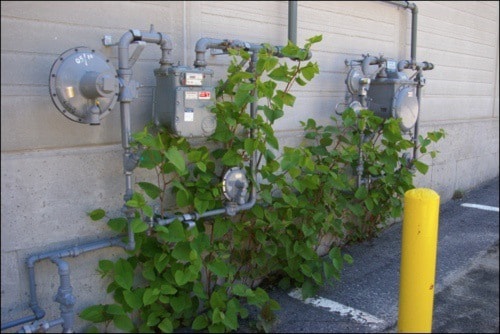Here are five reasons to remove knotweeds from your yard:
1. Creeping roots of knotweed can push through your house foundation.
2. It can grow up through your pavement.
3. Along stream banks it can increase flooding or completely block access for wildlife and people.
4. It can creep into your neighbours property creating problems for them.
5. It can affect property value – in the UK it has reduced property values, and made it more difficult to get a mortgage or house insurance.
So many gardeners love this plant, but it really is not that desirable in a yard. The potential negative impacts to our streams or the Kettle River are really not worth the risk.
There are four species of knotweeds that occur in B.C.: Giant knotweed (Fallopia sachalenensis), Japanese knotweed (Fallopia japonica), Bohemian knotweed (Fallopia x bohemica) and Himalayan knotweed (Polygonum polystachyum). All four species can be recognized by their heart, or triangle-shaped leaves, white-green flowers that bloom in late summer and bamboo-like stems.
Knotweeds spread rapidly through root systems. Exposed roots along waterways will break off and float downstream where they form new infestations.
These plants often move in soil so be careful that any topsoil you bring in does not contain it.
Help prevent spread by removing all plant parts from clothing, pets, vehicles and equipment before leaving an infested area.
If you decide to remove it from your yard, carefully plan how you will control. Mowing and cutting can work if done twice a month between April and August for several years.
Make sure to dispose of all plant parts properly.
Don’t compost it, it is better to bag it and take it to the landfill. Hand pulling will result in aggressive re-sprouting of the plant, and is usually not recommended.
Barriers can help after a few years to suppress new sprouts, but often it grows through the barriers.
Chemical control is the most effective either through stem injections or application to leaves.
Effective herbicides include imazapyr, glyphosate and triclopyr.
For more information on control of knotweeds or other invasive species, contact the Boundary Invasive Species Society at boundaryinvasives@gmail.com or 250-446-2232.
– Kristen Small, Boundary Invasive Species Society
